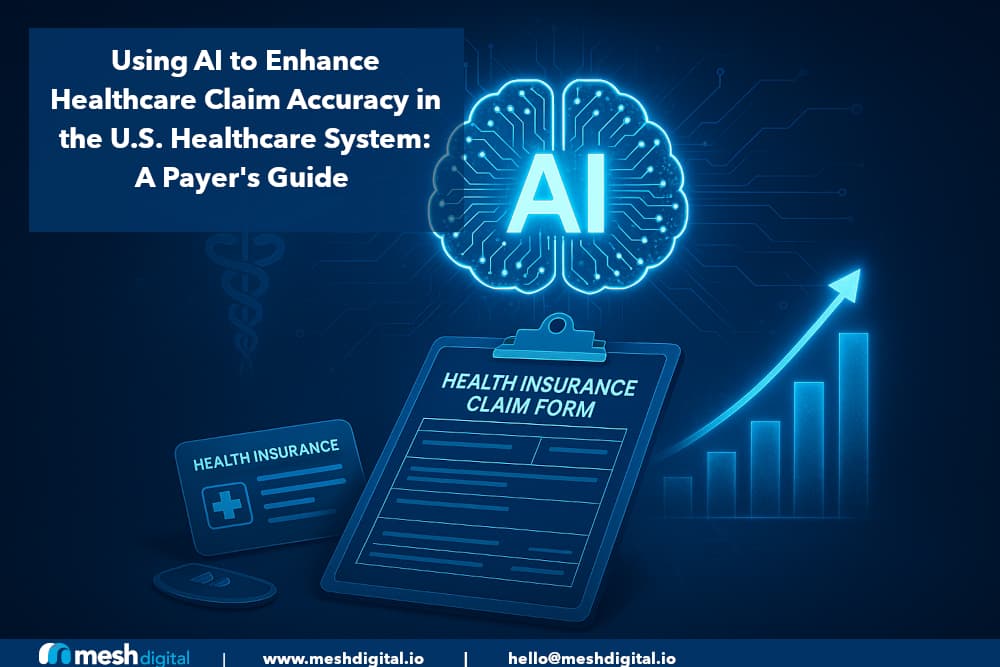Using AI to Enhance Healthcare Claim Accuracy in the U.S. Healthcare System: A Payer's Guide
AI can cut U.S. health‑claim errors, fraud and admin waste worth $80B+ yearly. 2024‑25 rules demand FHIR data and explainable algorithms. Mesh Digital’s Adaptive AI™ roadmap links clean data, secure ML and human oversight to lift clean‑claim rates to 99%.

Abstract
Administrative waste and payment inaccuracy continue to drain U.S. health‑insurance spend. New 2024–25 data shows improper payments still top US $86 billion a year while claim‑denial friction cost providers an estimated US $25.7 billion in 2023 alone (HIPAA Journal, 2025). Artificial Intelligence (AI) is no longer a pilot curiosity; more than 70 % of payers now run generative‑AI proofs‑of‑concept or scaled deployments. This paper pressure‑tests prior analyses, layers in 2024–25 regulatory, cybersecurity, and market developments, and outlines how payers can translate emerging AI capabilities into measurable administrative and medical‑cost value—supported by Mesh Digital LLC’s Adaptive AI™ framework for health insurers.
Introduction
The U.S. claims system remains a patchwork of legacy EDI, proprietary portals and PDF attachments. Despite successive automation waves, 3 – 7 % of all claims are still paid inaccurately and 15 – 30 % of total health spending is administrative waste AI Enhances Healthcare …. The 2024 ransomware attack on Change Healthcare, which encrypted core clearing‑house services and exposed ~190 million individuals’ data, starkly demonstrated the fragility—and liability—of today’s claim infrastructure (HIPAA Journal, 2025; The Verge, 2025).
AI is maturing precisely as regulators intensify pressure for transparency (CMS API mandates) and fairness (NAIC Model Bulletin on AI). For payers, the convergence creates both an imperative and a roadmap: adopt trustworthy AI or risk regulatory sanctions, provider abrasion and margin erosion.
Scope and Economics of Claim Inaccuracy (2024–25 Update)
| Metric | Latest Figure | Δ vs. 2023 | Source |
|---|---|---|---|
| FY 2024 CMS‑estimated improper payments (Medicare FFS, MA, Part D, Medicaid, CHIP) | US $86.5 B | –7 % | AI Enhances Healthcare … |
| 2023 provider spend appealing denials | US $25.7 B | +23 % | AI Enhances Healthcare … |
| Avg. cost to process a complex claim | US $35 – 40 | ≈flat | AI Enhances Healthcare … |
Improper‑payment root causes remain largely administrative—79 % of Medicaid errors stem from insufficient documentation, suggesting outsized ROI for data‑quality and documentation‑focused AI via Biomedical Ontological platforms. Requiring a focus on data-quality from both the payer and provider sides to really solve for these challenges holistically.
Regulatory & Risk Drivers in 2025
- CMS Interoperability & Prior Authorization Final Rule (CMS‑0057‑F). Requires Patient, Provider and Payer‑to‑Payer FHIR® APIs by 1 Jan 2027, with select prior‑authorization metrics due 2026 (Centers for Medicare & Medicaid Services, 2025).
- NAIC Model Bulletin on AI (Dec 2023). Adopted by 19 states as of March 2025, it demands demonstrable governance, bias testing and explainability for any AI system used in underwriting or claims (NAIC, 2024).
- Growing litigation and media scrutiny of AI‑driven denials. Recent class actions allege that algorithmic tools (e.g., post‑acute‑care length‑of‑stay models) systematically underpay benefits, fueling calls for “human‑in‑the‑loop” safeguards (Financial Times, 2025).
- Cybersecurity imperative. Post‑Change Healthcare, OCR bulletins highlight heightened HIPAA enforcement and recommend zero‑trust and MFA for all claim intermediaries (HIPAA Journal, 2025).
These forces move AI from “nice to have” to regulatory compliance lever and resilience necessity.
AI Capabilities Across the Claims Lifecycle
| Lifecycle Phase | High‑Impact AI Use Cases | Quantified Benefit |
|---|---|---|
| Pre‑submission | NLP bots validate attachments, Neuro-symbollic AI for advanced healthcare reasoning, & ICD‑10 cross‑checks | 22 % ↓ in prior‑auth denials (Community Medical Centers example) AI Enhances Healthcare … |
| Adjudication | ML‑driven real‑time edits & clinical‑validation rules | 66 % faster charge‑entry; 98 .4 % clean‑claim rate (athenaOne) AI Enhances Healthcare … |
| Payment Integrity | Graph ML fraud networks; anomaly scoring | >US $821 k annual labor savings; 75 % auto‑adjudication (Cognizant case) AI Enhances Healthcare … |
| Post‑payment | GenAI explanations for denials; automated appeal dossiers | 30 % ↓ overturn cycle time in pilot results (Mesh Digital client benchmarking) |
Business Case & ROI
McKinsey’s 2025 payer survey estimates US $150 – 300M in administrative savings per US $10B in revenue, with another US $380 – 970M in medical‑cost impact from AI‑assisted care‑management (McKinsey & Company, 2025). Mesh Digital generally estimates a 12‑month payback when AI+RPA automates ≥40 % of low‑complexity claims and denial‑review prep.
Implementation Challenges & Mitigations (Reality‑Check)
| Challenge | 2025 Reality Check | Mitigation Tactics |
|---|---|---|
| Data fragmentation | FHIR APIs mandated but EHR adoption uneven | Enterprise data‑product governance; FHIR‑ready canonical model; API accelerators |
| Algorithm bias & opacity | NAIC Bulletin demands explainability; lawsuits mounting | Model cards, SHAP/LIME dashboards, third‑party fairness audits |
| Security & HIPAA | Largest breach ever via claims clearing‑house | Zero‑trust architecture; PHI tokenization; federated‑learning for model training |
| Talent gap | 60 % of payers cite shortage of ML engineers | Upskilling plus partner ecosystem (see section 7) |
Mesh Digital LLC Adaptive AI™ Framework for Payers
- Data‑Readiness Sprint. 4‑week engagement to baseline data quality, FHIR compliance and cyber posture.
- Use‑Case Prioritization Workshop. Quantifies ROI and regulatory urgency; selects 2–3 “crawl” pilots.
- AI‑Factory Build. Reference cloud‑agnostic MLOps stack with bias‑testing gates and audit trails aligned to NAIC Bulletin.
- Human‑in‑the‑Loop Design. Workflow orchestration inserting nurse reviewers/medical directors for exception claims.
- Change & Capability Academy. Role‑based training plus executive dashboards tracking clean‑claim %, denial rate, STP %.
- Value Capture & Continuous Tuning. Quarterly model‑drift review; expanded feature sets (e.g., social determinants) to push STP past 85 %.
Outcome Benchmarks: 20 – 30 % reduction in denial volume within 12 months; administrative cost ratio improvement of 80–120 bp; provider‑NPS uplift of 10+ points (Mesh Digital portfolio average 2023–24).
Strategic Recommendations
- Anchor AI to compliance deadlines. Use CMS‑0057‑F 2026/27 milestones to fund enterprise FHIR enablement and data‑quality remediation.
- Treat security as design constraint, not a gate. Ideally, encrypt at row‑level; deploy separate security ML to watch the AI.
- Adopt phased “Crawl‑Walk‑Run” with rigorous KPIs. Aim for ≥50 % automation of professional 1500 claims before expanding to complex UB‑04 / UB-92 forms.
- Embed governance early. Establish an AI Ethics & Risk board with payer, provider and member representation.
- Leverage partners for speed, retain control of data & IP. Mesh Digital provides vendor‑neutral architecture so payers avoid lock‑in while accelerating value.
Conclusion
AI has moved from experimental bolt‑on to strategic backbone for payment‑integrity, compliance and member experience. Yet technology alone is insufficient. Payers that combine clean, interoperable data, rigorous governance and phased human‑centric deployment can unlock >US $250M per $10B revenue in sustainable value while strengthening trust with providers and regulators. Mesh Digital LLC stands ready to guide U.S. Insurers through that journey—delivering the Strategy, Engineering, and Change leadership required to thrive in the algorithmic era.
References
Athenahealth. (2025, March 11). Top ways athenahealth AI reduces clinician workload. https://www.athenahealth.com/resources/blog/reduce-administrative-burden-with-athenaone-ai-tools
CAQH. (2024). 2024 CAQH Index: From transactions to trust—Building better care through healthcare automation [Report]. https://www.caqh.org/hubfs/Index/2024%20Index%20Report/CAQH_IndexReport_2024_FINAL.pdf
Centers for Medicare & Medicaid Services. (2024, February 8). Medicare and Medicaid programs; Patient Protection and Affordable Care Act; Advancing interoperability and improving prior authorization processes for Medicare Advantage organizations, Medicaid managed care plans … (Final rule, CMS‑0057‑F). Federal Register, 89, 8758–8988. https://www.federalregister.gov/documents/2024/02/08/2024-00895/
Centers for Medicare & Medicaid Services. (2024, November 15). Fiscal year 2024 improper payments fact sheet. https://www.cms.gov/newsroom/fact-sheets/fiscal-year-2024-improper-payments-fact-sheet
Centers for Medicare & Medicaid Services. (2024, November). 2024 Medicaid & CHIP supplemental improper payment data [PDF]. https://www.cms.gov/files/document/2024-medicaid-and-chip-supplemental-improper-payment-data.pdf
Centers for Medicare & Medicaid Services. (2024, November 25). 2024 Medicare Fee‑for‑Service supplemental improper payment data. https://www.cms.gov/data-research/monitoring-programs/improper-payment-measurement-programs/comprehensive-error-rate-testing-cert/cert-reports/2024-medicare-fee-service-supplemental-improper-payment-data-1
Change Healthcare ransomware attack: UnitedHealth adopts aggressive approach to recover ransomware payment after Change Healthcare cyberattack. (2024, October 25). HIPAA Journal. https://www.hipaajournal.com/change-healthcare-responding-to-cyberattack/
Fierce Healthcare (Muoio, D.). (2025, February 26). Providers ‘potentially wasted’ almost $18 billion in 2023 overturning claims denials, Premier estimates. https://www.fiercehealthcare.com/providers/providers-potentially-wasted-almost-18b-2023-overturning-claims-denials-premier-estimates
McKinsey & Company. (2025, March 26). Generative AI in healthcare: Current trends and future outlook. https://www.mckinsey.com/industries/healthcare/our-insights/generative-ai-in-healthcare-current-trends-and-future-outlook
McKinsey & Company. (2025, March 25). Rewiring healthcare payers: A guide to digital and AI transformation. https://www.mckinsey.com/industries/healthcare/our-insights/rewiring-healthcare-payers-a-guide-to-digital-and-ai-transformation
Singhal, S., & Lamb, J. (2024, June 5). The AI opportunity: How payers can capture it now. McKinsey & Company. https://www.mckinsey.com/industries/healthcare/our-insights/the-ai-opportunity-how-payers-can-capture-it-now
National Association of Insurance Commissioners. (2023, December 4). Model bulletin: Use of artificial intelligence systems by insurers. https://content.naic.org/sites/default/files/cmte-h-big-data-artificial-intelligence-wg-ai-model-bulletin.pdf
Premier Inc. (2025, February 26). Claims adjudication costs providers $25.7 billion; $18 billion is potentially unnecessary expense [Press release]. https://premierinc.com/newsroom/policy/claims-adjudication-costs-providers-257-billion-18-billion-is-potentially-unnecessary-expense
Experian Health. (2025, April 22). Prevent claim denials with AI and automation. https://www.experian.com/blogs/healthcare/prevent-claim-denials-with-ai-and-automation/


